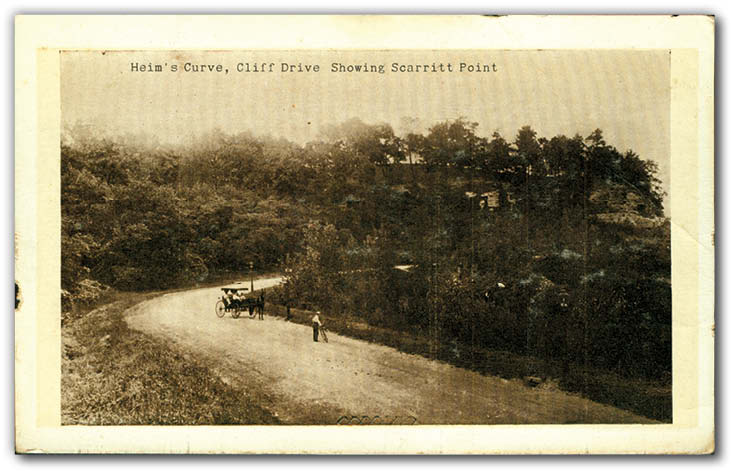By Michael Bushnell
Northeast News
February 17, 2016
The scene depicted on this Real Photo postcard published by the Mid-West Postcard company shows a mule pulling a horse cart and a man pushing a bicycle along Cliff Drive below Scarritt Point. The cliffs located in Historic Northeast Kansas City offered noted Landscape architect George Kessler a great challenge.
Kessler, for whom the park is named, had a great dream of developing Kansas City’s natural terrain and natural beauty with parks and boulevards encircling the entire city. With the backing of the city’s first Parks Board, Kessler set to work on Cliff Drive.
The first section of the drive was completed and opened to the public in 1900. It meandered through the wooded hills of then named North Terrace Park. Pictures of the day show laborers using horse and mule teams to haul rock and dirt for the completion of the drive. Later, the drive was lit by gaslights, spaced about 100 feet apart, lighting both the drive and its four approaches.
People from throughout the Midwest enjoyed drives along the rugged bluffs overlooking the Missouri River bottoms. The spring, as shown here, is located on the east end of Cliff Drive. The image shows how the spring looked after the city’s Parks Department “tapped” the spring, creating this shell and bowl, making it easier for passers-by to enjoy. The shell, however, was covered in the 1970s after it was found that the spring water had been contaminated. During a mid 1980s makeover, spearheaded by concerned Historic Northeast residents, the spring took on a new shape, that of a spectacular waterfall.
An obviously jilted John Monroe sent this card to Miss Nettie Tripplis at 4406 Troost Ave. on Dec. 31, 1909.
The message reads: “Nettie, I would like for you to call me up. My phone number is 2338 — main or home. [Editor’s note: There were two telephone companies in Kansas City at the time, Main and Home.] I hope you will be pleased with this postcard and to know I thought enough of you to write it. Answer soon. Call Friday, 12 am. John Monroe.”
A side bar note instructs the post office to return the card to the K.C. Mantle Company in five days if not “called for.”
What would he have thought to know that 100 years later, his plea would once again be published?




















